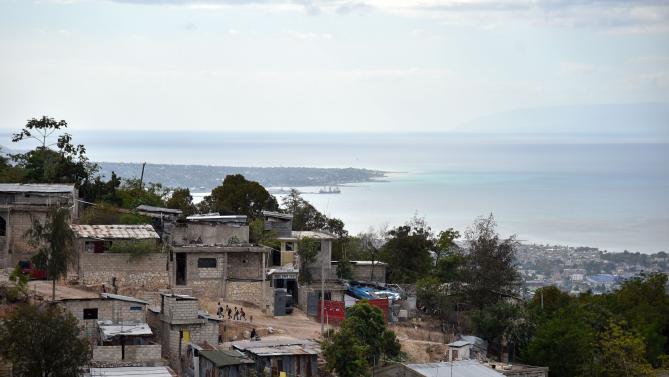[ad_1]

View of the Sainte Marie neighborhood in Port-au-Prince, Haiti, on Feb. 19, 2016, with the Bay of Port-au-Prince in the background
HECTOR RETAMAL/AFP/Getty Images
Last Friday, the dean of Harvard Law School, Martha Minow, endorsed the demands of student activists to change the school’s official shield, which contains the crest of Isaac Royall, a plantation and slave owner. The endorsement comes months after students at Princeton University made similar demands. They petitioned the university to rename the Woodrow Wilson School of Public and International Affairs.
Wilson, the 28th president of the United States, was a proponent of racist policies that sequestered opportunities for millions of African Americans. But the students are also challenging the president’s larger global white supremacist legacy. For the reverberations of Wilsonian racism, look no further than the island nation of Haiti. The two countries share a revolutionary heritage that began with independence—the U.S. in 1776, then Haiti in 1804—against European colonialism. However, that shared legacy was short-lived as racism increasingly defined U.S. policies toward the Haitian republic.
On July 28, 1915, the Wilson administration sent the United States Marines to invade Haiti. The president feared the rise of a well-integrated, but small, German-Haitian elite that intermarried Haitians to bypass the constitutional prohibition against foreign land ownership. As a result, this small contingent of Germans rivaled the U.S. influence in the country, an advantage Wilson tried to deter.
In 1914, Wilson deployed the Marines into Haiti for the sole purpose of recovering $500,000 from the coffers of Haiti’s national bank. The administration then transferred Haiti’s financial reserves to the First National City Bank of New York. The island nation had not been immune to similar U.S. interventions. In 1824, Haitian President Jean-Pierre Boyer signed the Franco-Haitian Agreement as part of which Haiti agreed to pay reparations to France for losses incurred by slaveholders during the Haitian Revolution (1791-1804). To avoid defaulting on the French indemnity, Haiti refinanced the debt through U.S.-owned banks. Between 1857 and 1914, the U.S. dispatched warships to Haiti to ensure payments.
In 1915, Haiti spiraled into chaos as its president was assassinated. President Wilson immediately sent in the U.S. Marines to supposedly impose order. The U.S. consolidated Haitian institutions and finances under the control of its Marine technocrats. A treaty was signed to create the Haitian gendarmerie (Garde d’Haïti), which mainly acted to suppress peasant revolts. In 1917, Wilson dissolved the Haitian Legislature and rewrote Haiti’s Constitution. Assistant Secretary of the Navy (and future President) Franklin D. Roosevelt boasted that he was the constitution’s architect.
Under the U.S. occupation, Haiti operated like a Caribbean protectorate of the Jim Crow South. Occupiers promoted a culture of U.S. imperialism with Southern Dixiecrats at the helm of government. They instituted a forced-labor system—the corvée—that forced peasants to build roads and railways, enchained and uncompensated. Other policies included censorship of the press and racial segregation that pitted light- versus dark-skinned Haitians.
W.E.B. Du Bois, the civil rights leader and son of a Haitian man, protested this virulent racism. The NAACP helped the U.S. Senate form an investigative committee that documented human rights abuses by the Marines. One example of these abuses was the assassination of Charlemagne Péralte, the leader of peasant rebels against the U.S. occupation. A photograph of Péralte’s body by a U.S. Marine photographer was distributed to instill fear. The image shows Peralte’s mutilated body crucified to a door with the Haitian flag mounted on a flagpole behind him.
When the U.S. withdrew from Haiti in 1934, it left behind a military police that ritualized the Marines’ repressive tactics to suppress political dissent. The 19 years of occupation resulted in the death of 15,000 Haitians. One hundred years after the invasion, Haiti remains on a trajectory of perpetual occupation by American and U.N.-backed forces. Maj. Gen. Smedley Butler, a U.S. Marine who served during the occupation, wrote years later that he spent his career as “a gangster for capitalism. … I helped make Haiti … a decent place for the National City Bank boys,” he confessed.
With the exception of the New Yorker, July 2015 (100 years since the U.S. invasion of Haiti) came and went with little commemoration from the American press. That is because President Wilson is lionized in American history. Admirers of Wilson overlooked his crimes against the Haitian people, which mirrored his attitudes regarding African Americans. We do not have to expunge his positive contributions from memory to acknowledge that black people did not need to be the casualty of his racist policies. But a conversation that reassesses the deleterious effects he had on blacks would be a thoughtful position to begin.
Westenley Alcenat is a Ph.D. candidate in U.S. and Caribbean history at Columbia University. He is currently a visiting scholar at the Massachusetts Institute of Technology and a visiting associate at the Weatherhead Initiative for Global History at Harvard University.
Like The Root on Facebook. Follow us on Twitter.
[ad_2]





















